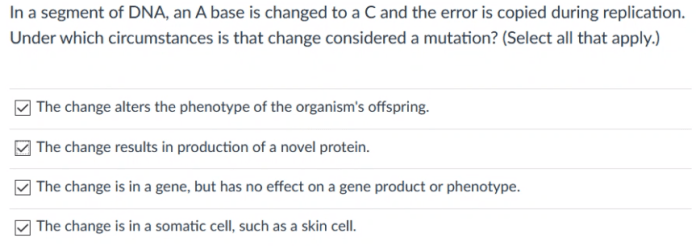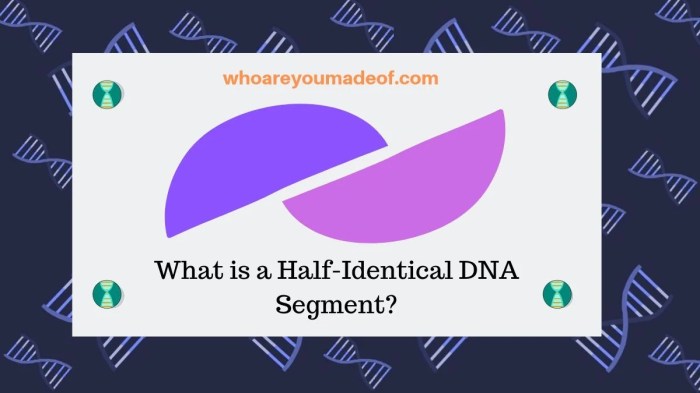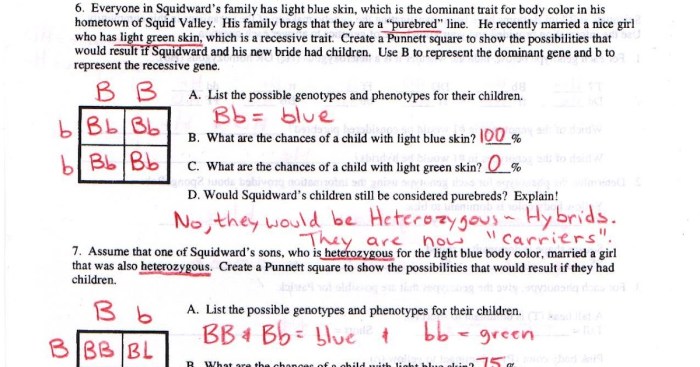A dna segment is changed from aattagtag to attagtag – DNA Segment Alteration: From AATTAATTAG to ATTATTAG unravels a captivating narrative that delves into the fascinating realm of genetic variation and its profound implications. This alteration sets the stage for an exploration of the mechanisms, effects, and applications of point mutations, providing a comprehensive understanding of their significance in shaping biological processes and advancing scientific frontiers.
Genetic Variation

Genetic variation refers to the differences in DNA sequences between individuals. It is the raw material for evolution, as it provides the genetic diversity necessary for natural selection to act upon. Genetic variation can arise from various sources, including mutations, genetic recombination, and gene duplication.
Point mutations are one of the most common types of genetic variations. They involve changes in a single nucleotide within a DNA sequence. Point mutations can have significant effects on gene function and protein structure, and they can contribute to the development of genetic diseases.
Types of Point Mutations
- Substitutions:These are the most common type of point mutation. They involve the replacement of one nucleotide with another.
- Insertions:These mutations involve the addition of one or more nucleotides into a DNA sequence.
- Deletions:These mutations involve the removal of one or more nucleotides from a DNA sequence.
Effects of Point Mutations, A dna segment is changed from aattagtag to attagtag
The effects of point mutations can vary depending on the location and type of mutation. Some point mutations may have no effect on gene function, while others can have significant consequences. For example, a point mutation in the gene that codes for the protein hemoglobin can lead to sickle cell anemia, a serious genetic disease.
DNA Sequence Analysis
DNA sequence analysis is a powerful tool for identifying point mutations. This technique involves determining the order of nucleotides in a DNA sample. DNA sequencing can be used to identify mutations that are associated with genetic diseases, and it can also be used to study the evolution of genes and populations.
Applications of Point Mutation Analysis
Point mutation analysis has a wide range of applications in medicine, forensics, and evolutionary studies. In medicine, point mutation analysis can be used to diagnose genetic diseases and to develop new treatments. In forensics, point mutation analysis can be used to identify individuals from DNA samples.
In evolutionary studies, point mutation analysis can be used to study the evolution of genes and populations.
FAQ Summary: A Dna Segment Is Changed From Aattagtag To Attagtag
What is a point mutation?
A point mutation is a change in a single nucleotide base pair within a DNA sequence.
What are the different types of point mutations?
Point mutations can be substitutions, insertions, or deletions, altering the sequence and potentially affecting gene function.
How can point mutations be identified?
DNA sequencing techniques, such as Sanger sequencing or next-generation sequencing, can be used to identify point mutations by comparing DNA sequences.
What are the potential effects of point mutations?
Point mutations can have varying effects, ranging from silent mutations with no impact to missense mutations that alter protein structure and function.
How are point mutations used in research and medicine?
Point mutation analysis is used in genetic testing for diagnosing diseases, studying evolutionary relationships, and developing targeted therapies.


